
It’s a bird…It’s a plane…It’s… a fish?
If you know anything about Duncan Aviation, you know we own and operate aircraft with some of the most unique paint schemes in the industry. There’s no Matterhorn-white-with-a-stripe here. Instead, there’s a baby blue Citation XLS with roses and ravens and a lime green Citation M2 with paint splatter. The aircraft are recognized worldwide, and are a testament to the creative people at Duncan Aviation, the quality of work they do, and the trust the Duncan family has in its team members.
At the request of Board of Directors Chair Todd Duncan, Aircraft Sales & Acquisitions Sales Rep Leah Alexander acquired a 10-year-old Pilatus PC-12 early in 2023 and immediately added the aircraft to our flight department.
“Todd had been interested in a PC-12 for some time, and we started serious acquisition discussions early in 2021,” said Leah. “Nevertheless, with the understanding that any aircraft would also be placed in our fleet in support of the company's operations, I performed detailed mission and budget analyses based on our flight department's actual trips and compared a number of models, including the Citation M2, Excel XLS, several in the CJ series, as well as the PC-12s.”
The door was open to pursue other 'good fit' models, but it was clear that a PC-12/47 in particular was both a good fit for the operation and the most desired model. The challenge was then to find a great PC-12/47 at a time when inventories were shrinking and prices were rising. A Colorado-based dealer who knew we were seriously looking for a PC-12/47 with a great pedigree brought this one to our attention before it was going to be openly marketed for sale.
“This aircraft truly ticked all of the boxes,” said Leah. “The transaction itself went incredibly smoothly in no small part because of the combined efforts of different teams across the company.”
The PC-12 was a well-used aircraft that had more than 4,000 hours total time, and desperately needed avionics modifications/upgrades, heavy maintenance, new paint, and a new interior.
We knew just the place to make this happen.
Todd Duncan knew the bar was high, and it would be difficult to match the popular and easily recognized paint schemes on the other company-owned aircraft.
“I tell people who have seen the one-off paint work on our company-owned aircraft that they are really the responsibility of my mother and father,” said Todd. “This one, was on me. I knew I had a high bar to match and it was going to be difficult. I leaned heavily on my dad for advice throughout the entire process.”
Matterhorn white with a stripe?
…far from it.
Todd has always had a passion for fishing and the outdoors. He has especially fond memories of when his dad would take him fishing in Canada.
“I was hooked as a little kid,” said Todd. “I’ve done it ever since I was little. I love taking my friends and family with me just like my dad did with me. It’s just something I love doing.”
When asked to describe the paint scheme, Todd said it’s an interpretation of what fishing is.
“It’s not a literal fish, it’s the experience,” he said. “To me, its about the experience you get when you go fishing, whether it’s a pond here in Nebraska, or somewhere more exotic. You load up all your equipment, grab the fellas, and go. That’s what this thing was built for, and I’m just so excited to take this all over the world.”
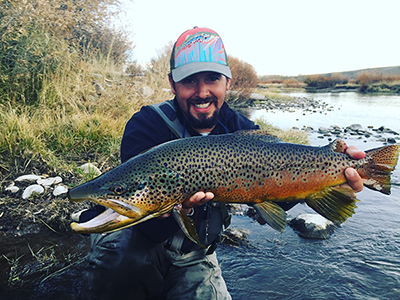
The commissioned design was created by Derek DeYoung.
“I had always admired Derek’s work” explained Todd. “He's a famous artist in the fishing world, and I noticed his work years ago. I was in a fishing store and saw an Abel fishing reel that had been hand- painted with his designs, and I fell in love with it. We tracked him down and encouraged him to design a paint scheme for this aircraft.”
Aircraft Sales & Acquisitions Sales Rep Robert Suarez contacted Derek, explained the situation, and asked if he would be interested.
“I said ‘heck yeah, who wouldn’t want to design a paint scheme for an airplane?’ I’m excited to work with anyone who comes to me with a great attitude and realistic expectation of my time,” said Derek. “We were able to come up with a plan and make it happen. I’ve done a ton of crazy, weird projects over the years, but nothing like this. To work with an actual paint department was pretty cool.”
Derek said the first thing Todd told him was that he loves going up to Canada, and that they take the plane on a lot of fishing trips. He also said he was looking forward to landing the aircraft up there and seeing people’s reactions.
Todd had told Derek that he’s a freshwater lake kind of guy, and loves the Northern Pike, Muskie, and Walleye. He wanted to look at the aircraft and be reminded of a freshwater fish.
Derek presented Todd with four separate designs. After back and forth about the technicality of painting an aircraft with these exquisite designs, and questioning if it could actually be done and how it would look, they decided on a design that closely reflects the Northern Pike, and matches Todd’s initial vision of landing the plane in Canada.
“Northern Pike are moss green with ivory-colored oval spots,” explained Derek. “I don’t just glance at fish. I try to find nuances and colors that maybe not every Pike has. A fish’s colors and patterns change with the lighting. Things can happen like a hologram and different colors show up purely based on the way you look at them. I knew the plane was something that we couldn’t go way complex on, based on the limitations. But, I couldn’t just do a moss green plane with ivory oval spots; that was not an option.”
The final design has an iridescent purple nose that fades into green with ivory spots that turn warm yellow toward the belly of the aircraft.
“It’s a beautiful interpretation of a Northern Pike,” said Derek.
To come up with the design, Derek took a schematic of the plane on his iPad and digitally painted the plane. The 2D design suggested how it would look, and the paint department had to decipher how it would look in 3D. Derek said the final product was as close as you could get with the type of application they were doing.
“The end product is a lot more simplified,” said Derek. “On my iPad I can take a tiny swipe of my pencil to add detail. It’s a lot more difficult to do that on a plane. It essentially becomes an interpretation between my work and the work of the Paint team, and I think they nailed it.”
When asked how he feels about knowing he’s responsible for designing one of the most unique private jets in the world, he responded humbly.
“I don’t look at it like that,” he explained. “Every day I have to paint the best paintings I’ve ever done because someone is trusting me to do that. Todd trusted me to do a great job, and if he feels like I did just that, then it makes me feel good about my work and what I’ve done. Together, we brought his vision to life.”
Derek said it was an exciting and fun process.
“This was one that took some patience and didn’t happen overnight,” he said. “I can’t wait to see Todd’s reaction the first time he touches down in Canada for his fishing trip. That’s when it’ll become apparent what he’s done.”
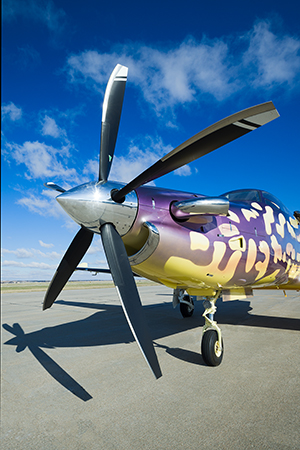
Paint Layout Technician Stacy Finch and Paint Crew Leader Trevor Reinke were ready for anything Todd could throw at them.
“This was different from anything we’ve ever done,” said Trevor. “A lot of the projects we work on are cut and dried. This was a little more than that, and we never had any doubts. My initial shock value when I got the portfolio of renderings was, ‘oh, my!’ The hardest part was getting started, so from there, we got to work.”
After receiving the artist’s renderings, Stacy came up with his own version of the design with the shapes that would fit the aircraft to scale, and made stencils that he could cut out. He also heavily researched the artist’s work.
The challenge with this paint scheme, aside from the obvious, was getting the blends and fades the way they were intended while trying to keep the correct shapes and the artist’s concept true. When Stacy and Trevor first looked at the artist renderings, they noticed there weren’t any hard edges.
“All of the shapes were faded on the edges, so we had to find a way to make the shapes and soften the edges as we went,” Stacy said. “It was challenging and took a little more time, but we were able to pull it off.”
To get those soft edges, the team outlined the shapes with foam tubing.
“It was a simple solution, and worked exactly as we expected,” said Stacy. “It was something we’ve never had to try before.”
The Paint team has completed a few projects where blends were involved, but nothing as complex as this. They had to turn it up a notch, as this was one of the most complex and unique paint schemes they’ve come across.
“My team is used to just painting in white, so when it came to the fades and stuff, they didn’t have much experience,” said Trevor. “They picked it up quickly, and the paint tech who was doing a lot of the actual painting, Tristan Bowen, had only been with us for a year.
They both said there was a lot of preparation that went into this job beforehand, and it was rewarding to know that Todd had full confidence in them.
“Knowing Todd had the confidence in us helped a ton,” said Stacy. “It made everyone on the team feel good about themselves and the work they do. Everyone communicated well and had the same vision, so it was no surprise we pulled this off.”
Trevor said he is very proud of the team.
“They got the final result,” he said. “It was great to see Todd that excited. When he walked through the door to see the plane for the first time, he was either going to love it or he wasn’t. And, he did.”
The aircraft featured 16 formulated colors. All were pearls, three of which were tri-coats. There are also about six to eight more colors that were blended together to help create some of the transitions and high- and low-light areas.
Todd said what really got him excited about this project was when he saw some of the Duncan Aviation Paint team look at him and say, “You know. We can do this. We can pull this off, and it’ll be fantastic.” He specifically remembers Paint Team Leader Brandon Boyer looking at him and saying that they can make this scheme happen, and it will be absolutely beautiful.
“It was a real team effort, and they stood behind their word,” said Todd. “They pulled it off. Having the creative talent behind you and the ability to do something different is the most fun a guy can have.”
Todd never intended for the exterior paint scheme to be replicated in the interior. He thought it should be separate in the way it looks and feels. Inside the aircraft, he was shooting for a Western Nebraska feel with natural colors and leathers, with a small hint of the exterior scheme. The interior is highlighted by unique stitching, hydrographics, and a few Easter eggs. The interior gives a homey feel that is elegant, bold, and custom.
Designer Jaime Blanken describes the cabin as cozy, yet modern and sophisticated, with bold pops of color on the conference tables and contrast stitching on the seats.
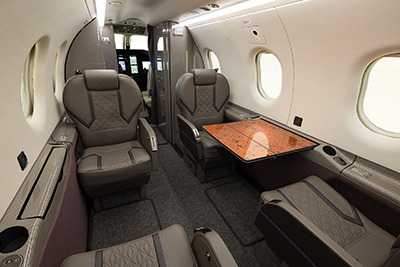
The seats are undoubtedly the highlight of the interior. The front four seats are a lighter, two-tone Torino Lakestone and Torino Appalachian color with contrasting purple double-stitching. The back two seats are a dark, single-tone Torino Appalachian color with orange single-stitching. The colored stitching is a way to bring just a dab of color into the interior of the aircraft through the exterior paint colors.
The combination within the seats with different leather colors, stitching colors and sizes, and unique quilting on the centerpiece inserts give them a distinctive look that you won’t find anywhere else.
During a meeting with the Design team, Todd recalls a thought he had.
“I had one of those moments where I was like, ‘Wait a minute, it’s our Interior shop, it’s our team. If we want to have two different colors of stitching, we can actually do this. We have the capability.’” Todd said. “I love that type of detail, and I know our customers do, too. It’s a unique consideration.”
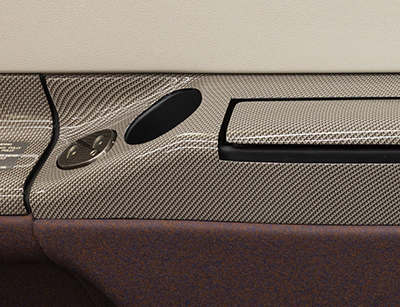
All of the cabinetry and drinkrails were created through a hydrographics process with a carbon fiber pattern that is the same color as the leather seats in the flight deck. The light-colored pattern opens up the interior and helps it feel more inviting. The inserts in the conference table are Copper Sheets that have a Dark Distressed Patina pattern and add a pop of color.
The seat backs were also hydrodipped, which is a first for Duncan Aviation.
“Since the seat backs are plastic, we were able to dip them and create a cohesive, unexpected touch,” said Jaime. “We also included a small Duncan Aviation logo on the back of the front four seats in a Purple Pearl to match the stitching when the sun hits it just right. The two back seats have an orange logo to coordinate with the orange stitching.”
Upholstery Master Specialist Tom Dirkschneider said this is the first time he’s done anything with applying hydrographics to a chair.
“They were in pretty rough condition when they came to us,” said Tom. “They look so good now, it’s unreal how far they’ve come. The hydrodipping is just another step up that gives the customer a good, high-quality product.”
Todd gives credit to the Interior and Design teams for the incredible creativity they have.
“We’ve been able to have some fun with this,” he said.
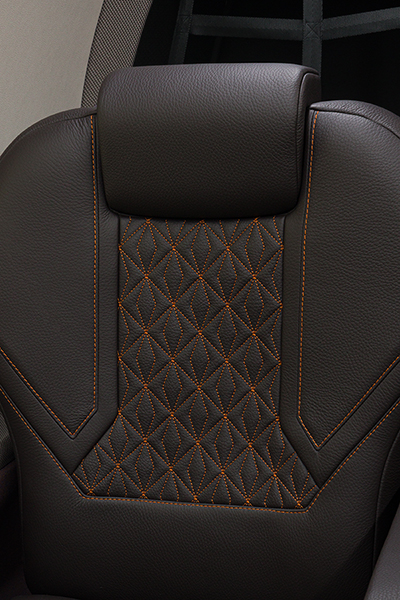
After receiving the drawings for the seats, Tom marked out the lines and where the stitching would go, then transferred those marks onto vinyl to create the patterns. He checked the width to 1/16th of an inch to ensure the sizes were correct and blended well. Between the backrest, the seat cushion, headrests, and leg rests, there were over 60 patterns to make all the different parts of the chair.
The purple double-stitching on the front four seats was stitched using a special sewing machine, but the rest of the stitching, aside from the quilted inserts, was hand-sewn by the Duncan Aviation team in Lincoln.
“The normal stitch used to sew two pieces of leather together is a size 69 thread,” explained Tom. “The purple and orange stitching on the seats is a larger thread, size 210. The larger thread sets off the stitching more and creates a unique look.”
Utilizing the new CNC quilting machine Duncan Aviation has at our Battle Creek. Michigan, location, custom diamond-patterned quilted inserts were crafted to add texture and focus to the seat design. The finesse it takes to maintain stitch tolerance within one millimeter displays the dedication to quality our upholstery shops have always maintained. These inserts showcase the technological advances Duncan Aviation is utilizing to provide not only the highest quality in the industry, but also the refinement of current seat designs. Capable of quilting, perforating, and embroidering, we can continue to exceed expectations.
The carpet was kept simple to allow the rest of the interior to shine. It is an Acousticord carpet that is normally only used for flight deck and baggage areas because it wears so well. All of the materials in the aircraft are durable and are able to be easily wiped down and cleaned after every trip.
“I didn’t want an interior that wouldn’t stand up to the task,” said Todd.
The lower sidewalls feature orange and purple wool fabric that brings in more color to contrast the rest of the cabin.
Jaime adds that it was very cool to see the aircraft come to life, and how many people it took to make that happen.
“It was a very fun project, and was an honor to work with Todd on his project,” Jaime said.
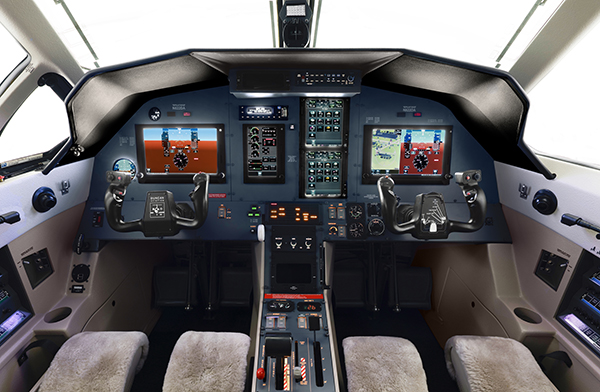
In addition to the customized paint and interior, a team at Duncan Aviation’s Satellite Shop in Denver, Colorado, outfitted the Pilatus’ flight deck with all new Garmin systems. The avionics upgrades provide the Pilatus pilots with more information, greater redundancies, and additional safety features. The flight deck also features a new instrument panel, fabricated by Nimbus Aviation.
The upgrade provided a significant weight savings over the old systems and wires.
“We weighed everything, including the wires, and by adding the new equipment, the Pilatus is now 162.23 pounds lighter!” says Edduyn Pita, Manager of the Denver Satellite.
The team in Denver removed all of the original avionics and wiring, and replaced it with a G600TXi, which includes new, color primary flight displays for the pilot and co-pilot, a Garmin Engine Indication System, and SVS (Synthetic Vision System) with terrain displays.
They installed a dual GTN 750XI, providing GPS Com Nav/Radar Indicator; the GFC600, an all-digital Autopilot; the GWX75 Radar system, and the GI275 Standby Instrument, which provides backup power in the event of an electrical malfunction.
The Denver team added USB outlets that connect to the GI275 for software updates. The pilots can also use the USB outlets to charge and power their tablets.
“I’m really proud of my team. They did a great job on the Pilatus,” says Edduyn. “The aircraft arrived with no interior. Three technicians from Lincoln accompanied the Pilatus, and they helped with defueling. In order to calibrate the new Engine Indication System, the plane had to be defueled first.”
Edduyn and his team then began the painstaking process of finding and removing unused wires. They pre-made the wiring and harnesses the new equipment would need before the Pilatus arrived, saving the team two weeks of downtime!
Check out the video showing how this fish-tale came to life.
Still need more?
Visit our dedicated PC-12 page here.
Among the many wires they installed were wires for AirText, a text-only system. Pilots and passengers will be able to send and receive texts, and the cabin now includes two USB outlets for charging, too.
In addition to Edduyn, his team included Team Leader John Watson, Crew Leader Cameron Lazar, Satellite Install Specialists Julia Langford and Douglas Riera Guzman, Sheet Metal Specialist Juan Medina, and RTS Inspector Chris Demarest.
“We were all here to welcome Todd Duncan and Michael Kussatz when they came to take delivery of the squawk-free aircraft,” says Edduyn.
Before any of the paint, interior, and avionics could happen, however, the aircraft needed maintenance work. Because Duncan Aviation is not authorized to perform maintenance work on Pilatus aircraft, the aircraft needed to be taken to KCAC Aviation in Olathe, Kansas, where it received its annual inspection and numerous repairs.
“Duncan Aviation has made their PC-12 uniquely theirs as they do through innovation and imagination,” said KCAC Aviation Director of Operations Tony Mateer. “KCAC Aviation is excited to be involved with this very innovative aircraft. Congratulations to the entire Duncan Aviation team that has again, created a masterpiece.”
Project Manager Jamie Wilson said it is gratifying to see a project as creative as this, from concept to fruition.
“Todd requested our team members’ input throughout the design process,” said Jamie. “It is wonderful working at a company where the owner wants team member input on their own aircraft.”
This aircraft highlights all the different artisans that work at Duncan Aviation. From the shop in Denver, to the Paint team, Interior team, and everyone else involved, an enormous amount of work went into this project and well over 100 team members played a role in the transformation.
“I absolutely love it,” said Todd. “You don’t really know what kind of fish, or if it’s even a fish. I love that about it. This is something that is unique to me. This is next-level and a lot of fun to be able to represent Duncan Aviation in.”
Todd credits his mom and dad, and their passion for unique things and their love of contemporary art.
“They gave me the ability to be creative and have fun,” said Todd. “I can’t even imagine my Grandpa Donald’s reaction. He’d absolutely love it and be enormously proud of us all. But, he’d be real interested as to where the story of Duncan Aviation is going in the next 10, 20, and 30 years, too.”
One word to describe this aircraft?
There isn’t.
“For me, this was a heck of a lot of fun,” said Todd. “We will have this aircraft for years to come, and we recognize the hundreds of team members who worked on the aircraft and turned a vision into reality. It’s just incredible.”
It’s far from being just a fish. It’s the testament of an experienced group of individuals coming together to turn a vision, into reality.